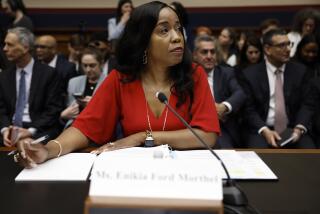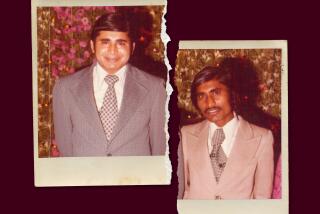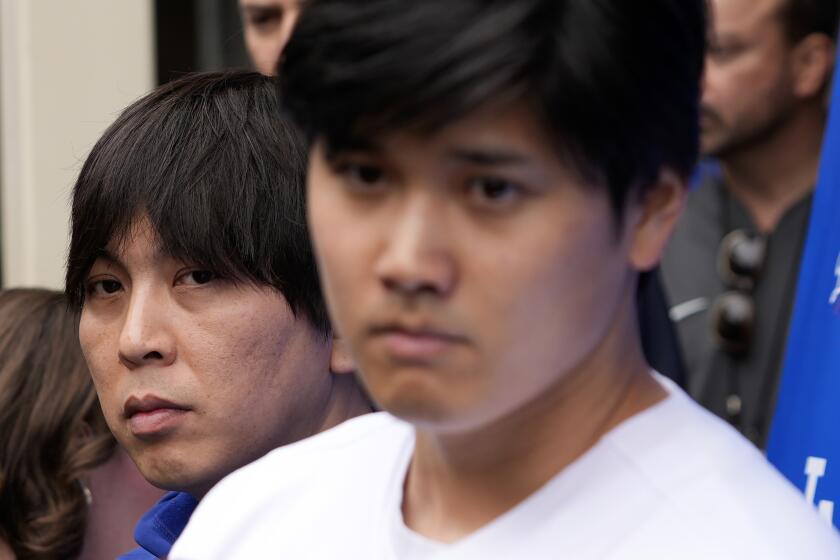Penn Witness Claims Police Attack : Incident Is Second Alleged Harassment of Defense Figures
A black former San Diego police officer who reluctantly testified for the defense in the Sagon Penn police murder trial said he was assaulted and harassed by two officers on Friday over a parking dispute.
Nathaniel Jordan is the second figure connected to the Penn defense within two weeks to allege police abuse following last month’s acquittals in the controversial police murder trial.
Jordan, an associate minister at Mount Zion Baptist Church who took a medical leave from the Police Department in December after seven years on the force, said a detective in plain clothes struck him in the back and a uniformed officer attempted to put a choke hold on him. The detective, who Jordan said he recognized from their joint assignment in the traffic division, approached Jordan as he sat in his car in a handicapped space with the engine running in a congested store parking lot on El Cajon Boulevard.
“I was really shocked and surprised (but) then I wasn’t,” Jordan said. “After testifying in the (Penn) case, I was almost certain something like this was going to happen. And it did.”
Called Danger to Police
Jordan was arrested on charges of resisting arrest and assaulting a police officer. According to police reports, Jordan pushed an officer in the chest and was restrained with a choke hold because of the danger he posed to police. Police reports list two witnesses as supporting the police version. They could not be reached for comment.
Jordan filed a complaint with the police internal affairs unit, and the incident is under investigation.
Police are also investigating complaints by Reiko Obata, the former head of the Sagon Penn Legal Defense Committee. Obata said she was harassed on Aug. 8 by two San Diego police officers who took her to jail on suspicion of driving under the influence even though a breath test revealed only a trace of alcohol.
After a urine sample later showed no alcohol or drugs, authorities dropped all charges against Obata, and are investigating her claim that the officers were rude and obnoxious and took her to jail because she was considered to have an attitude problem.
Both Jordan and Obata say they were singled out for abusive treatment by police because of the roles they played in the Penn trial. The case has caused deep friction between the Police Department and the city’s minority communities.
Jordan testified during Penn’s second trial that Police Agent Donovan Jacobs once called him a “nigger” and frequently used racial slurs while making arrests. As chairwoman of the Penn defense committee, Obata organized rallies critical of police conduct and was widely quoted on television and in newspapers.
“We are extremely sensitive to any appearance that we would do something like that,” Cmdr. Keith Enerson said of the allegations by Jordan and Obata. “These are unfortunate coincidences that both of these people were connected to the Penn trial. . . . We are really a large department with almost 1,700 sworn officers. I think a very small percentage of officers know personally any of the people who were involved in the Penn trial. That is behind us. We’ve got other things to worry about.”
Penn, a 25-year-old black man, was acquitted of most charges after a second trial in the March 31, 1985, shooting death of Agent Thomas Riggs and the wounding of Jacobs and civilian passenger Sarah Pina Ruiz. The defense argued that Penn defended himself from a racist attack launched by Jacobs.
Testified Reluctantly
Jordan was the defense’s final witness to testify. He jolted prosecutors when he said that Jacobs routinely used words like “nigger” and “boy” while dealing with black prisoners. Jordan, who worked with Jacobs on the street narcotics enforcement team in 1982 and 1983, said he nearly came to blows with Jacobs during a squad conference when Jacobs called him “a nigger” after Jordan confronted the officer about his handling of a situation in the field.
In an interview, Jordan said he did not testify in the first trial and did not want to testify in Penn’s retrial because he feared police retribution. But he agreed to tell the truth once the court, on behalf of defense attorney Milton J. Silverman, issued a subpoena requiring Jordan to testify.
“Because of the time I spent on the department, I knew I would be labeled a snitch,” said Jordan, who joined the police force in 1979. “It would cause problems. There would be retaliation.”
The altercation began Friday afternoon when Jordan pulled into the corner shopping center on the 2500 block of El Cajon Boulevard to get ice cream for two 9-year-old boys who play on his Pop Warner football team. Jordan said he sent the boys into the store and sat in a handicapped space with the engine running because no other spaces were available and several cars were double-parked.
Jordan said a detective, whom he recognized as veteran Officer Ronald King, came out of a municipal employees’ credit union and approached his car. (The police report makes no mention of whether King recognized Jordan.) King told Jordan he couldn’t park in the handicapped space and ordered him to move his car. When Jordan said he did not want to stop traffic and would wait momentarily for the boys to return, King called for a uniformed officer to issue a citation.
Enerson acknowledged that it was unusual for a detective in plainclothes to become involved in a parking violation.
“Normally, we wouldn’t do that,” Enerson said. “I suspect that in this case the officer saw the person pull in and told him he was in a handicapped zone. . . . I would say that most officers wouldn’t do anything and probably would call (a uniformed officer).”
When Officer John McGill arrived, he ordered Jordan out of the car and requested identification, Jordan said. As he was pulling his driver’s license out of his wallet, Jordan said, King struck him in the back from behind, probably with his knee. Jordan said that he turned around and Rice tried to apply a standard police choke hold.
Familiar With Maneuver
Because he was familiar with reverse holds, Jordan said, he was able to grab McGill’s fingers and prevent the officer from choking him unconscious. Jordan was then handcuffed and put in the back seat of a police car.
“I sat on El Cajon Boulevard for 45 minutes on display for every cop to see,” Jordan recalled. “The cops came by looking. There were about 12-16 police officers in all. I heard ‘We got Nate Jordan’ clearly. They were laughing.”
One witness, Bernard Davis, whose 9-year-old son was one of the passengers in Jordan’s car, said he overheard the officers after the incident talking about what they were going to write in their reports.
“King was doing the orchestrating,” Davis said. “He was saying, ‘This is what you put down. That he came up and he pushed us and we tried to put him in a choke hold.’ ”
Jordan was the aggressor and initiated the confrontation, according to police reports. King said he twice asked Jordan for his identification as a former police officer, but that Jordan refused and became “very hostile.” When Jordan tried to walk away, according to reports, McGill and King blocked his way; Jordan then allegedly tried to push his way through McGill and King, but the officers blocked him in.
A police report, written by investigating Officer Jerome Rice, said: “Jordan again attempted to walk through Officer McGill and King. He was blocked in again. Jordan took his wallet out of his rear pants pocket and handed it towards Officer McGill. Jordan suddenly turned towards King and stated, ‘Keep your hands off of me, chump.’
“Jordan stepped forward and struck King in the chest with both of his hands. Jordan’s hands were held palms out and his fingers were pointed upward. King was pushed back a couple of feet. Officer McGill placed a (neck) restraint hold on Jordan . . . “
In his report, McGill wrote: “Jordan got within six inches from my face and told me, ‘I’m a retired policeman’ . . . Jordan mumbled something and then, with open hands, struck King on his chest, knocking King backwards approximately five feet. Fearing for King’s safety, I placed a (neck) restraint on Jordan. I applied minimal pressure on Jordan and leaned him on his vehicle. . . . Jordan flexed his arm muscles when we tried to handcuff him.”
Jordan was taken to police headquarters, cited for assaulting an officer and resisting arrest and released. He then walked to the front counter and filed a complaint against the officers.
Police spokesman Enerson, when asked if he believed a former police officer and Baptist minister such as Jordan would strike an officer, said, “I don’t know that the pushing was a real violent action. I think the facts stated in this report really happened. I think there was some anger that got out of hand. I can’t see that a reasonable person parked in a handicapped zone wouldn’t move his car and get in an altercation over it.”
More to Read
Start your day right
Sign up for Essential California for news, features and recommendations from the L.A. Times and beyond in your inbox six days a week.
You may occasionally receive promotional content from the Los Angeles Times.






